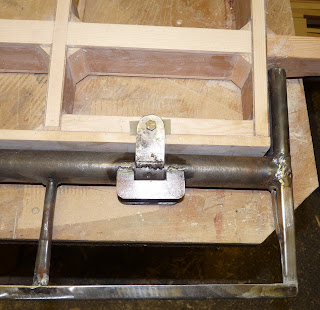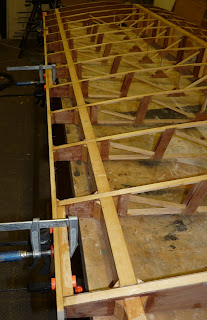
As the glue laminating the front spar was now properly set, I could create the root shapes for the spars and the tapers at the wingtips. Having built a computer controlled router I decided to use this to do the work. So I programmed the outlines of the four ends into Cambam which is CAM software with some limited 2.5D CAD capability. Then I positioned the first spar ready for the cut. Mach 3 software is used to control the machine. Good practice is to try the machine program with the cutter set above the workpiece so that you can observe the pattern without cutting the wood. Once I was satisfied with the program, the cutter height was set down and the program started for real. In fact on the first end of each spar there would be an opportunity to redo the cut in the event of problems as the stock material was long enough but this wouldn't be the case on the second end. In fact, the cuts all went well and the programs can be re-used for the second wing.

At the root ends I used the program to cut 3/4" holes where the bolts will go. These will be filled with some special bushing material epoxied in which will be final drilled to the finished size. This ensures that the bolts will not move in the wood and increases the strength of the joint by increasing the diameter of the hole in the wood.
I was particularly pleased with the wing tip taper cut on the main spar shown in the second picture. Trying to do this by hand would have been difficult and the router did a perfect job (last picture).
The cutter used is a 1/4" carbide cutter specifically designed for wood. I set the program to cut 1/8" deep at each pass, first cutting 1/16" outside the cut line and then at each depth cutting exactly up to the line. The linear rate of cut was set to 16" per minute. So to

cut the full 1-1/4" depth of the main spar takes 20 passes - quite slow but a perfect result.
The holes were drilled with the same 1/4" cutter. The computer control moves the router bit in precise circles and the result is far better than could be achieved with any sort of wood drill and is of course perfectly vertical. Also the size can be adjusted to get just the right sort of fit to allow the bushing to be inserted and leave enough room for the glue layer.

 Yesterday I positioned the left wing ribs onto the main and rear spars, drilled and screwed the inner leading edge and aileron spar into position and glued the spar root doublers and bushings into place. Today I drilled the main spar attach bracket to the spar. You can see the yellow swarf in the foreground that comes from drilling through the phenolic linen bushes - strange stuff!
Yesterday I positioned the left wing ribs onto the main and rear spars, drilled and screwed the inner leading edge and aileron spar into position and glued the spar root doublers and bushings into place. Today I drilled the main spar attach bracket to the spar. You can see the yellow swarf in the foreground that comes from drilling through the phenolic linen bushes - strange stuff!


























